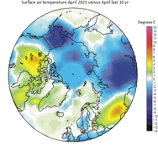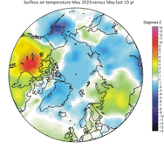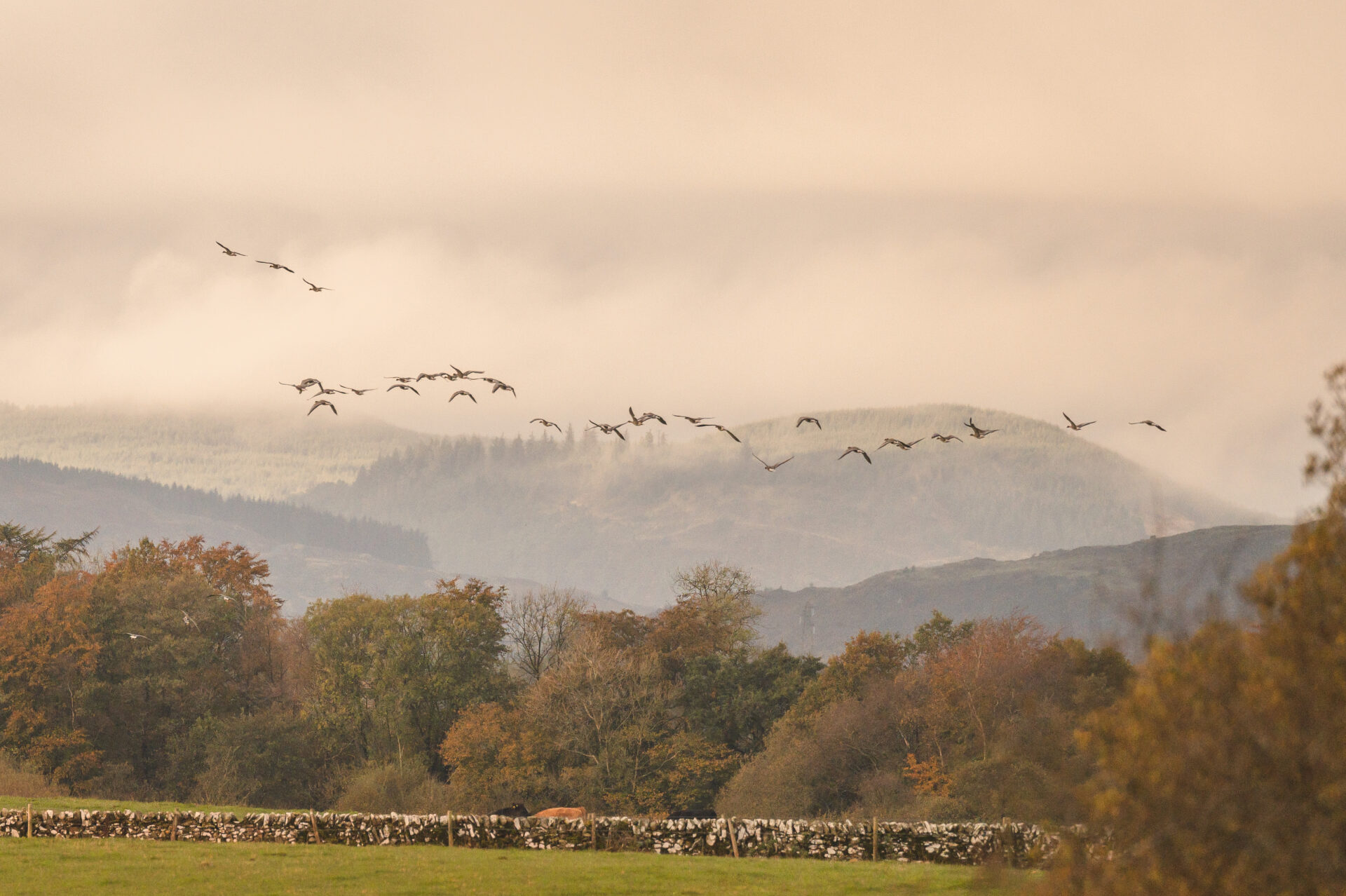Photo by Duncan Ireland
Dr Larry Griffin of ECO-LG Ltd, tells us about local goose movements and the migration of Geese in and around Dumfries and Galloway.
Learn more about the changing climate and how this affects migration, as well as different goose populations and the development of young geese.
By Dr Larry Griffin
September is always an exciting time of year for the goose ecologist working in Scotland as the birds we put tags on, often many years ago, are now just starting to show up as “pings” on our tracking maps after what can only be described as a brooding silence after they headed north out of phone signal range in May.
Of course, we can watch our local resident greylag geese on these maps every day if we wish at Goose News and indeed can catch up with them every hour at exciting times during the breeding season or currently when they are starting to move about more within the region, tracking stubbles cleared of crops or making bigger moves to find food as one did last autumn when it head to the Yorkshire Dales before being shot at Christmas.
Watching our local goose movements though cannot really compete with the excitement and anticipation of seeing which of the tagged, truly migratory High Arctic breeders has survived, and hopefully which have had a successful breeding season, whether it be a Svalbard barnacle goose or a Greenland white-fronted goose.
Successful breeding for these two species has now taken on much greater significance as barnacle goose numbers were hit hard by the Avian Flu outbreak two winters back and after more than 10,000 died, dropped back to just over 30,000 birds, with two decades of conservation effort wiped out overnight.
The global population of the Greenland white-fronted goose is in an even more perilous state after a continued tumble in numbers saw their flyway population sitting at levels not seen since the 1980s at between 17-18,000 birds; shocking really when there were close to 35,000 just 25 years ago. So, for them, every brood counts and until they arrive back on the fields and wetlands at Loch Ken near Threave and West Freugh near Stranraer – the sites of the only two flocks of close to 150 each in southwest Scotland – we must content ourselves with looking through parted fingers at what the data downloading each day from their tags can tell us…
For the white-fronts unfortunately I have to say that the omens do not look good as it is possible to get a reasonably good indication of the breeding season they are likely to have had from an understanding of weather patterns that prevailed during May and June in their west Greenland breeding areas.



Temperature anomalies in the Northern Hemisphere in April, May and June 2023 (white = normal, blues = colder than 10yr average, greens to red = warmer than 10yr average). Data Source here. Courtesy of: NASA Goddard Institute for Space Studies (GISS).
If looking at the temperature anomalies for April, May and June we can see the sorts of anomalies that make it so difficult under increasingly skewed weather patterns for the geese to “predict” foraging conditions at subsequent northern sites in a chain along the international flyway where such sites are many hundreds of miles apart. In April, Iceland, where the whitefronts stop off for a month to feed after leaving the UK the signal was that things were warmer than usual and so the grass will have been growing well and the birds may have been getting restless to leave ahead of schedule as the aim of the geese is always to arrive on High Arctic breeding grounds as soon as possible to get the best breeding sites and benefit from the fresh nutritious vegetation for their chicks on hatch; so in essence they need to get ahead of spring.
However, as we can see if they did make the jump across the Greenland ice cap in early May what they will have found is conditions that were somewhat colder than usual and that these persisted into June when conditions chilled even further compared to usual. So, the signals the geese were getting about the progress of spring in Iceland could have put the geese out of sync with what they might have expected in Greenland.
This of course is not a new problem for the geese and they are adapted to cope with such things to an extent by building up good fat reserves and by being incredibly well insulated, but climate models suggest such anomalies are increasing and will continue to increase in the future and so the geese may become more and more conflicted as to the best time to leave Iceland for Greenland.
Such variable conditions are unlikely to kill the adult geese themselves but what it does likely mean in 2023, as in 2022 which was their worst breeding season on record, is that when they arrived in west Greenland they will perhaps have been greeted by more frosts and snow than usual and this means it will have been harder to dig into the ground for roots or to forage on the surface for greenery. Thus it will have been difficult to replace body reserves lost during the long migratory flight over the ocean and ice cap and for females to increase reserves for egg laying. The geese are fairly plastic in how they can respond to such prevailing conditions and instead of nesting in mid-to late-May they might well have deferred into June, though as the graphic depicts things might have been even colder then compared to normal, so the signs for successful breeding by the whitefronts in 2023 are again not good…
For the Svalbard barnacle geese the indicators on these graphics are less clear cut as they mostly do not arrive at their breeding sites until mid- to late-May and so the slightly warmer or average conditions in west Svalbard in June should mean that their breeding season went largely unchecked though these maps do not show how wet it was, and rain post-hatch can be a negative factor for early chick survival.
Like the moult period covered in the previous blog, the breeding season, what with the weather effects and numerous predators is a very tricky time, as is migration and now we are at the tail end of summer and into autumn the birds are starting to migrate with any new families they managed to raise. Thus as I write in the last ten days of September, the whitefronts have just reached southern Iceland and some are still arriving, and I’m getting reports of observations of flocks of barnacle geese heading south along the coast of Norway, so things are definitely happening. Three whitefront tags that I deployed on whitefronts over 4-6 years ago are showing up on the webpages now and as they start to download their backlog of data from the past 4 months it will be exciting to check the GPS fixes for late May/early June for tight clusters when the female did not move about much, hopefully staying in a 50m area for about 24 days which should mean a successful incubation. Two of these birds were originally tagged at West Freugh (tag ‘YH’ and ‘PIFO53’).
Although the whitefronts are just arriving in Iceland, the pink-footed geese for which D&G and the Solway has such great renown (see the many Peter Scott paintings and prints in our local antique shops), left there for Scotland at the start of September, being some of the earliest movers; not surprising considering they are able to get down to nesting earlier too.
No doubt many of you will have already heard them heading over the town at night in Dumfries or elsewhere or seen the skeins heading inland of a morning; they set the tone for autumn with their distinctive calls and the classic symmetry of their flight line formations and are quite a pretty goose with their pink bill marking and legs and what in some lights appears to be a pale dusting of frost on the wings. Endlessly communicating in their family groups as they shuffle across the stubbles it’s easy to forget that the young birds, perhaps 6 or 7 in a family group, and subtly different in appearance to the adults, were just a circle of yellow in the “white” liquid of an egg just 3 months back; that all of our young geese, or indeed any bird, can shift from that apparently simple binary state to a fully functional and complex sentient being in such a short space of time totally floors me when I think about it.
This may sound odd for the alleged “scientist in residence” of the Wild Goose Festival to say and I do not mean that I think like this all the time, it’s just that suddenly it can strike you every now and again when you think about such things for a bit longer.
Throughout my education I have come to understand how chick development happens and the sorts of processes that take place at the egg formation stage and onwards. However, even though I can recall the ordered coloured diagrams in glossy text books, the names of the developmental stages and the role of DNA and proteins etc., those diagrams represent things in a massively abstract way at 1000’s of times the size of the actual processes, which are actually monumentally and vanishingly small. As Richard Dawkins said in one of his later books, DNA is not a blueprint, there isn’t a kind of plan somewhere in the microscopic patch of one or two cells that starts out to build the whole goose from the pool of liquid and fat it sits on. What happens is that parts of the DNA switch on at different times and different proteins get constructed and they then build other cells and proteins which build others, such that it is all about the relations of chemicals to one another and the physics of those relations and how such tiny players self-organise to start along a developmental path and self-regulate through feedback loops. It is about diffusion and about compounds and timings and having enough energy in a concentrated form for four weeks to run these tight processes and handle waste products within the confines of an egg that fits in the palm of your hand; that is about all I can think of to sum it up.
It is nuts that it achieves so much in such a short space of time and that all it needs is a bit of warmth from the sitting female and is such a tight run ship that out of 7 eggs laid 7 may hatch into fully functional goslings able to feed for themselves and make decisions. It does baffle me completely and I realize that I have little more understanding of it all than a simple “belief” in the process.
When I was a teenager at Southampton University, I remember that one autumn day at about this time of year there was a sudden storm whipped up after I left a lecture and I rapidly sought shelter in a brutalist out of the way gallery building I had not noticed before. I have thought of it little since but at the time there was an exhibition on and no-one else was there and it was called ‘Automata’. Basically it was lots of little machines doing stuff, I cannot remember precisely what, but all were up to something and presumably had some small power source or magnets hidden somewhere that let the activities play out over and over in a cyclic way as they built things or went about their business – perpetual motion hadn’t been invented then and still hasn’t, but even so it was mesmerizing and when I stepped back outside into the real world I remember that things looked different and more elementally connected for about an hour or so, the leaves rolling about were being physically pushed by the hand of the wind, the ivy tendrils growing down the wall and cleaning an arc of algae off it were like powered windscreen wipers, the clouds moved like a Baron Munchausen set. Anyway you get the gist and as a further analogy that may be a step too far towards trying to gauge this self-perpetuating-self type imagery I am thinking along the lines of a completely pulverized city of London, rubbed out and grinded down to all of its elementary particles and substances, all the streets, buildings, wires, lights, computers, and other infrastructure, everything; this vat of semi-solid liquid then has a small metal origami seed thrown into it that unfolds and unfolds and draws on the viscous liquid for growth while it gently simmers in an absurdly large pan, with butter fat thrown in occasionally for energy. After 3 months or so an exact London is born again in all its intricacies, connections and details, possibly a simple analogy that falls well short of the complexities of an egg to chick transformation from the chemical gloop of its contents but perhaps not, I don’t know.
Anyway, even with all that, the grown chick makes its move, like London shifting to Madrid or some such event when it has no real clue it could do such a thing and was quite happy existing as London in London. Another dimension of what the fledgling London/goose was capable of yet had no clue about beyond a gradual bubbling of hormones and chemicals and impulses that gradually suggested something needed to change and the change involved heading south. Absolutely amazing, navigating all those miles when the neonate had no experience of that sort of thing and after only 3 months… who knew.
So, for all the pink-footed geese completing their first epic journeys from Iceland (and the Icelandic graylag geese so depleted in numbers and moving up the list of conservation concerns) it does seem odd that we greet them at the start of September with a barrage of gunshots, and perhaps the Wild Goose Festival celebrations can make amends and proffer that we are capable of a much warmer welcome for these marvellous beings.
